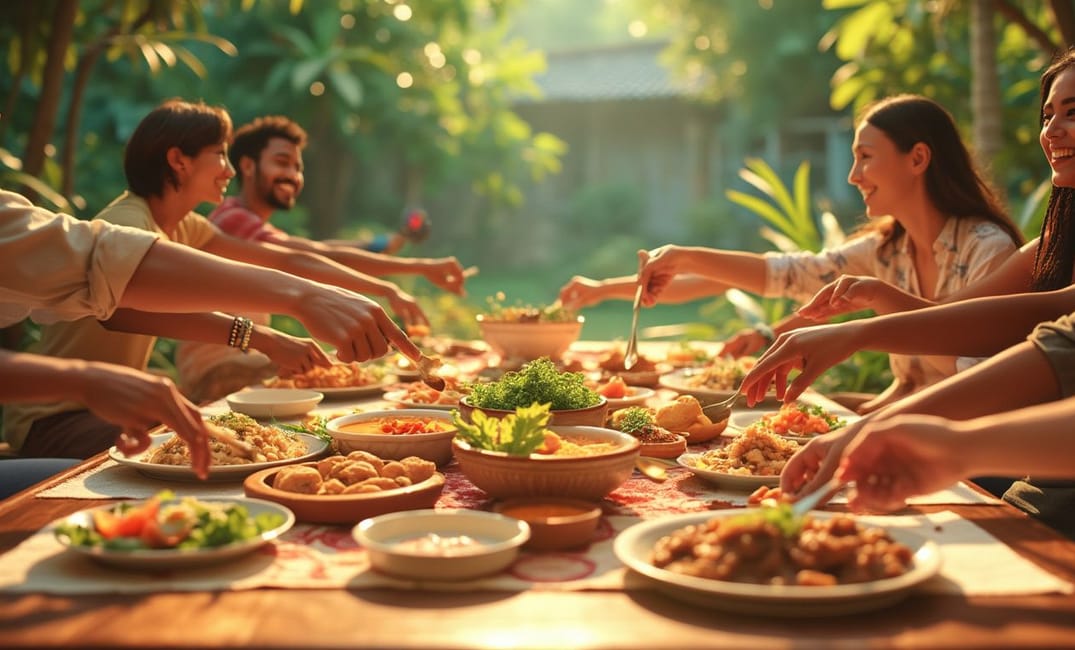Introduction: The Kitchen as Humanity’s Cultural Hearth
Food does more than just nourish our bodies—it is a compass guiding us through the culture, history, and stories of humanity. Embedded in every recipe and shared meal is a conversation that transcends borders and generations. This culinary dialect is essential not only for survival but for cultural identity, interwoven with narratives of migration, adaptation, and innovation. From ancient grains to molecular gastronomy, the art and science of food unveil the shared heritage and diverse creativity of human communities. Today's entry explores this conversation through the multifaceted journey of human culinary traditions, revealing how each bite we take is a taste of our collective human story.
The Genesis of Nourishment: From Gathering to Growing
The Hunter-Gatherer Epoch
- Foraging and the Origin of Flavor: Early humans were foragers, skillfully identifying edible plants, nuts, seeds, and fruits. This lifestyle required intimate ecological knowledge, as foraging dictated mobility and seasonal cycles in communities. Flavors varied wildly with geography, fostering diverse culinary strategies across regions.
- Hunting and Cooking Mastery: Hunting introduced protein-rich diets and fostered community skill development, with early humans mastering fire and toolmaking to process meat. Cooking expanded dietary options and preserved food, enabling broader exploration and adaptation to new environments.
The Agricultural Revolution
- Domestication of Crops and Animals: The transition to agriculture around 10,000 BCE marked a pivotal shift. Communities established permanent settlements, cultivating staple crops like wheat, barley, and rice, and domesticating animals for milk, wool, and meat, setting the foundation for diverse culinary innovation.
- Culinary Techniques and Specialization: Advancements like fermentation, drying, salting, and dairy production stem from early agriculture, each process adding layers of taste and aiding in sustenance during lean seasons. Over millennia, these techniques evolved into sophisticated methods defining cuisines.
Culinary Traditions: Reflecting Societal Narratives
Regional Flavors and Identity
- Cultural Symbolism in Cuisine: Each region's cuisine is a reflection of its environment and history, showcasing materials available and unique adaptations to climate and cultural exchanges. For example, the spices that characterize Indian curries or the pasta shapes in Italy are interwoven with their respective cultures and histories.
- Traditional Dishes as Cultural Anchors: Dishes associated with celebrations, like Turkey in American Thanksgiving or Mooncakes in the Chinese Mid-Autumn Festival, exemplify how food fortifies cultural heritage and communal identity, privileging shared rituals that persist through generations.
The Migration of Foods
- Trading Routes and Spice Trails: Food is a traveler, notable in the Silk Road exchange, where spices, fruits, and grains moved across borders, transforming palates and culinary practices globally. The spice trade not only defined economies but also sparked exploration narratives that have shaped world events.
- Diaspora and Culinary Fusion: Migration and colonialism transported culinary traditions across continents, leading to richly blended cuisines. The African influences in Caribbean cooking or Asian flavors in America's West Coast illustrate this profound fusion, creating new cultural expressions and identities.
Culinary Innovation: The Science and Art of Food
Transformations in Taste
- Evolution of Cooking Tools and Techniques: From earthenware pots to sous-vide, human inventiveness continually reinvents cooking, exploring textures and flavors. The development of metal implements, and later electrical appliances, revolutionized foodie thoughts, broadening culinary possibilities and encouraging imaginative artistry.
- Fermentation and the Alchemy of Flavors: Fermentation transcends mere preservation, representing a symbiotic culinary dance that transformed materials into prized delicacies like cheese, wine, and kimchi over centuries—our ancestors mastering beneficial bacteria to yield treasured flavors distinct to cultural identities.
The Advent of Modern Gastronomy
- Molecular Cuisine and Beyond: Pillars of modern cuisine like molecular gastronomy challenge conventional culinary boundaries, employing science to reimagine flavors, textures, and experiences. This innovation, highlighted by chefs like Ferran Adrià and Heston Blumenthal, reflects an artistic intersection between culinary tradition and futuristic exploration.
- Sustainability and Culinary Economics: With global awareness shifting toward ecological welfare, innovative culinary methodologies focus on sustainability, embracing farm-to-table approaches, and reducing waste. Chefs and farmers collaborate to introduce heirloom and forgotten varieties, enhancing biodiversity and eco-conscious food production.
The Global Culinary Dialogue: Bridging Cultures
Communion and Storytelling
- The Dining Table as Cultural Crossroads: Meals unite individuals, fostering dialogue and understanding across cultures, languages, and generations. Family recipes and shared gatherings are vessels of histories, echoing narratives of ancestors while forging new memories and connections.
- Food Festivals and Cross-Cultural Exchange: Events like food festivals facilitate cultural exchanges, showcasing diverse culinary forms and fostering international diplomacy through shared tastes and experiences, thus celebrating the universal language of food.
The Digital Era and Food Network Influence
- Culinary Globalization via Media: The internet and media share regional cuisines in unprecedented ways, driving a newfound culinary curiosity and understanding. Food blogs, reality cuisine shows, and cultural vlogs are ambassadors of culinary traditions, sparking widespread kitchen experimentation.
- Food as a Bridge for Unity: Today's digital platforms empower culinary voices globally, spotlighting indigenous recipes and culinary practices that might otherwise remain obscure. This accessibility promotes culinary inclusivity, weaving culinary wisdom across global tables.
Conclusion: Humanity's Culinary Tapestry
Through the universal language of taste, culinary traditions capture the essence of what it means to be human. Every culinary evolution is not only a tale of sustenance but also a chronicle of culture, geography, and human creativity. By understanding the diverse origins and innovations within the culinary world, we unite disparate pieces of a collective history that spans from ancient hearths to modern kitchens. As humanity ventures into the future, sustaining its cultural stories through food is imperative—not only for survival but for the continued dialogue of shared existence.
"In each dish lies a constellation of stories—whispers of ancient hands and future dreams, a melody of spices invoking the dance of humanity’s odyssey on Earth, savoring a narrative that binds our past and heralds our coming together across cosmic plains."
STORYTELLING, MIGRATION, GASTRONOMY, CULINARY TRADITIONS, CULTURE, SUSTAINABILITY, INNOVATION, FOOD, HISTORY, IDENTITY

